Determining Your Ideal Diamond Shape (Part 1)
Posted on Wednesday, January 27th, 2016
in Diamond, Informational.
With so many different diamond shapes to choose from, it can be confusing to determine which shape is the best for you. Depending on the type of look you’re going for, one diamond shape could be perfect while another one should be avoided. For this week’s blog, we’re going to highlight some of the important information you should know about the most popular diamond shapes: round, princess, emerald, Asscher, and cushion.
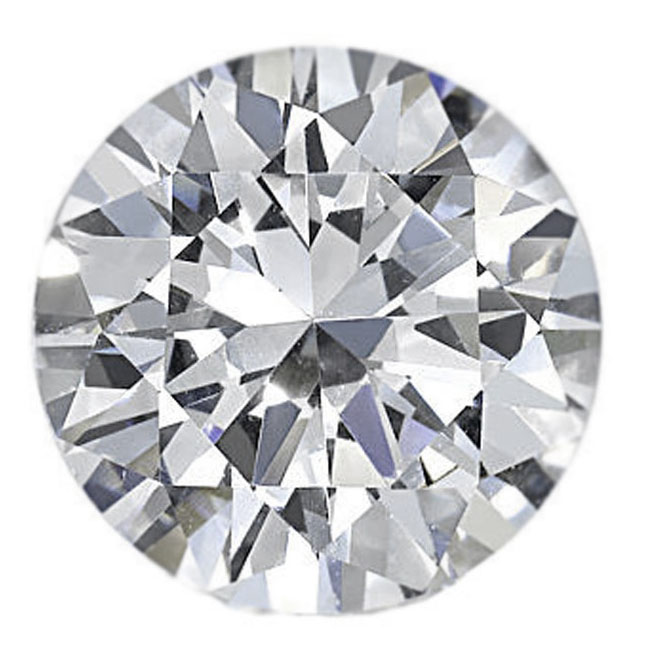 Round diamond:
Round diamond:
There’s a reason why this style is the most popular type of diamond shape. Round diamonds tend to maximize the brightness of a diamond, creating a breathtaking sparkle. Most round diamonds are brilliant cut, which means they have either 57 or 58 facets (the name for smooth surface areas that have been cut at different angles to allow light to enter and reflect back on the diamond). Because of their higher demand and larger percentage of diamond loss during the cutting process, round diamonds are generally more expensive than other shapes.
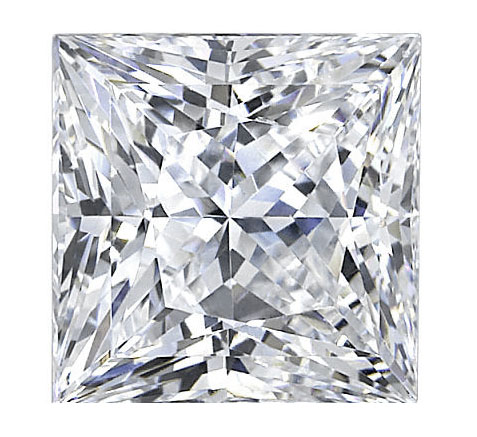 Princess diamond: With a similar sparkle and brilliance found in round diamonds, princess diamonds come in as the second most popular type of diamond shape. Unlike round diamonds, princess diamonds are in the shape of a square or rectangle and have four pointed corners. This relatively new diamond style was created in the 1960’s and was designed for maximum brilliance. The number of facets on a princess diamond can vary widely. Since princess diamonds have four pointed corners, it’s important to make sure that all corners are well protected with prongs, which will protect the diamond from potential chipping.
Princess diamond: With a similar sparkle and brilliance found in round diamonds, princess diamonds come in as the second most popular type of diamond shape. Unlike round diamonds, princess diamonds are in the shape of a square or rectangle and have four pointed corners. This relatively new diamond style was created in the 1960’s and was designed for maximum brilliance. The number of facets on a princess diamond can vary widely. Since princess diamonds have four pointed corners, it’s important to make sure that all corners are well protected with prongs, which will protect the diamond from potential chipping.
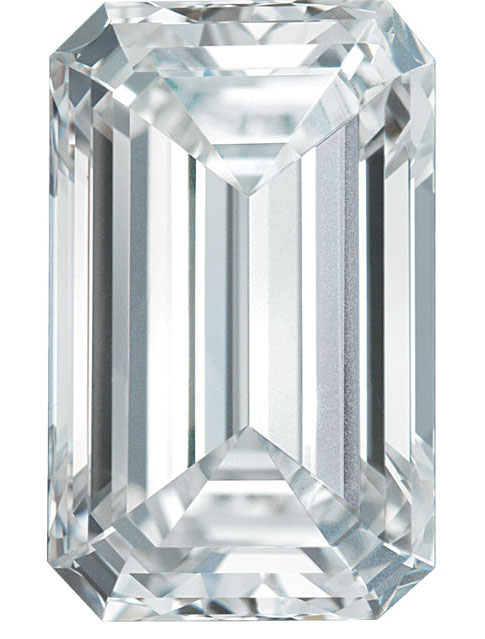 Emerald diamond: This type of diamond shape features long, narrow facets in rows and tends to emphasize the clarity of the diamond. Most emerald diamonds are rectangular shaped and have long lines which give the diamond a sophisticated and elegant look. Unlike princess diamonds, emerald diamonds have truncated corners instead of pointed ones. Emerald diamonds are a type of step-cut diamond, meaning their facets are rectilinear and arranged parallel to the diamond’s girdle. Traditional emerald diamonds have three tiers or steps of facets on both the crown and the pavilion of the diamond, for a total of 49 facets. Even though they don’t have the same amount of sparkle compared to other styles, emerald diamonds are still favored for their vintage style and clarity.
Emerald diamond: This type of diamond shape features long, narrow facets in rows and tends to emphasize the clarity of the diamond. Most emerald diamonds are rectangular shaped and have long lines which give the diamond a sophisticated and elegant look. Unlike princess diamonds, emerald diamonds have truncated corners instead of pointed ones. Emerald diamonds are a type of step-cut diamond, meaning their facets are rectilinear and arranged parallel to the diamond’s girdle. Traditional emerald diamonds have three tiers or steps of facets on both the crown and the pavilion of the diamond, for a total of 49 facets. Even though they don’t have the same amount of sparkle compared to other styles, emerald diamonds are still favored for their vintage style and clarity.
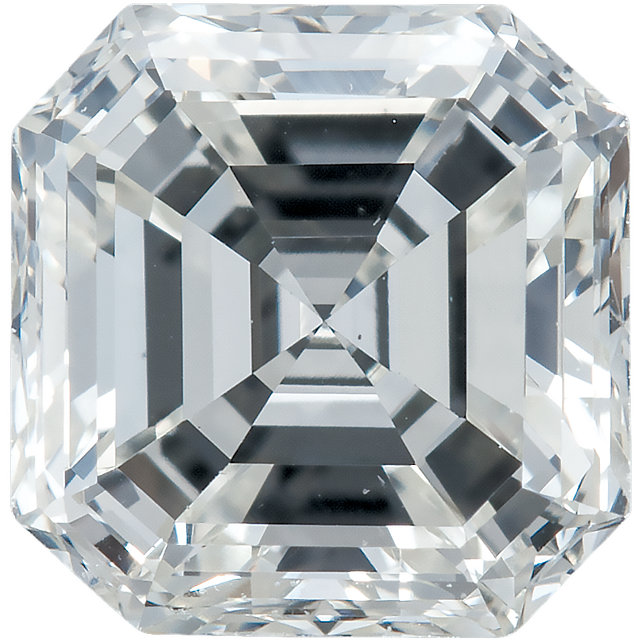 Asscher diamond: Asscher diamonds are very similar to emerald diamonds except for a few key features. The most noticeable is that they are square shaped instead of rectangular. They also usually feature larger step facets, a higher crown, and a smaller table, which tends to create more brilliance than an emerald diamond. Like emeralds, Asscher diamonds have cropped corners. Similar to emerald, one downside to Asscher diamonds is their lack of brilliance. Because of this, defects in color and clarity will be more visible to the eye than other diamond shapes. Therefore, only diamonds with a high clarity and high color grade should be cut in this manner.
Asscher diamond: Asscher diamonds are very similar to emerald diamonds except for a few key features. The most noticeable is that they are square shaped instead of rectangular. They also usually feature larger step facets, a higher crown, and a smaller table, which tends to create more brilliance than an emerald diamond. Like emeralds, Asscher diamonds have cropped corners. Similar to emerald, one downside to Asscher diamonds is their lack of brilliance. Because of this, defects in color and clarity will be more visible to the eye than other diamond shapes. Therefore, only diamonds with a high clarity and high color grade should be cut in this manner.
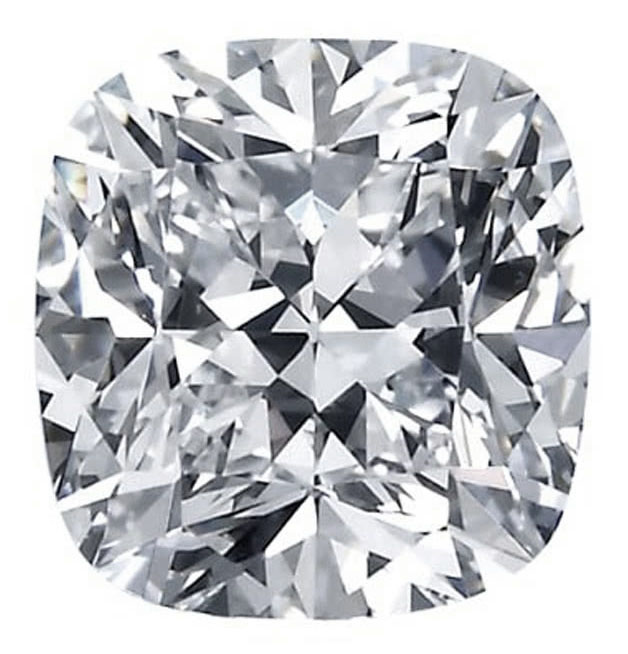 Cushion diamond: Diamonds with this type of cut feature a pillow-like shape, somewhere between an oval and a rectangle. Cushion diamonds tend to have round corners and curved sides. While round diamonds are best for hiding color, cushion diamonds are meant to retain color. This is in thanks to the variations in their facet patterns. Because of this, cushion diamonds are common among fancy colored diamonds and less popular among colorless diamonds. The one downside to this shape is that they tend to have larger facets, which mean inclusions may be more noticeable. For this reason, one should pick a cushion diamond with a high clarity grade.
Cushion diamond: Diamonds with this type of cut feature a pillow-like shape, somewhere between an oval and a rectangle. Cushion diamonds tend to have round corners and curved sides. While round diamonds are best for hiding color, cushion diamonds are meant to retain color. This is in thanks to the variations in their facet patterns. Because of this, cushion diamonds are common among fancy colored diamonds and less popular among colorless diamonds. The one downside to this shape is that they tend to have larger facets, which mean inclusions may be more noticeable. For this reason, one should pick a cushion diamond with a high clarity grade.
Click here to see the differences between oval, marquise, pear, heart, and radiant diamonds.


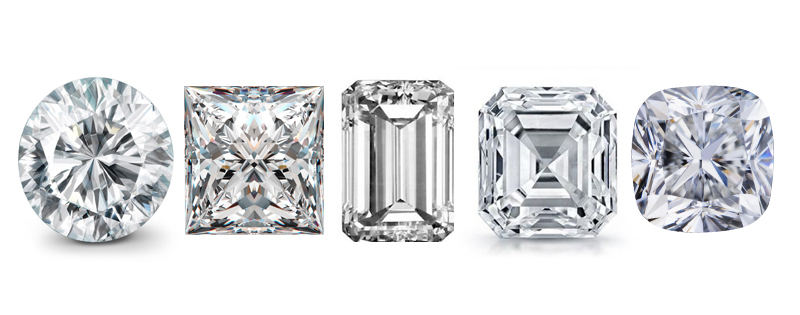
 Round diamond:
Round diamond: Princess diamond: With a similar sparkle and brilliance found in round diamonds, princess diamonds come in as the second most popular type of diamond shape. Unlike round diamonds, princess diamonds are in the shape of a square or rectangle and have four pointed corners. This relatively new diamond style was created in the 1960’s and was designed for maximum brilliance. The number of facets on a princess diamond can vary widely. Since princess diamonds have four pointed corners, it’s important to make sure that all corners are well protected with prongs, which will protect the diamond from potential chipping.
Princess diamond: With a similar sparkle and brilliance found in round diamonds, princess diamonds come in as the second most popular type of diamond shape. Unlike round diamonds, princess diamonds are in the shape of a square or rectangle and have four pointed corners. This relatively new diamond style was created in the 1960’s and was designed for maximum brilliance. The number of facets on a princess diamond can vary widely. Since princess diamonds have four pointed corners, it’s important to make sure that all corners are well protected with prongs, which will protect the diamond from potential chipping. Emerald diamond: This type of diamond shape features long, narrow facets in rows and tends to emphasize the clarity of the diamond. Most emerald diamonds are rectangular shaped and have long lines which give the diamond a sophisticated and elegant look. Unlike princess diamonds, emerald diamonds have truncated corners instead of pointed ones. Emerald diamonds are a type of step-cut diamond, meaning their facets are rectilinear and arranged parallel to the diamond’s girdle. Traditional emerald diamonds have three tiers or steps of facets on both the crown and the pavilion of the diamond, for a total of 49 facets. Even though they don’t have the same amount of sparkle compared to other styles, emerald diamonds are still favored for their vintage style and clarity.
Emerald diamond: This type of diamond shape features long, narrow facets in rows and tends to emphasize the clarity of the diamond. Most emerald diamonds are rectangular shaped and have long lines which give the diamond a sophisticated and elegant look. Unlike princess diamonds, emerald diamonds have truncated corners instead of pointed ones. Emerald diamonds are a type of step-cut diamond, meaning their facets are rectilinear and arranged parallel to the diamond’s girdle. Traditional emerald diamonds have three tiers or steps of facets on both the crown and the pavilion of the diamond, for a total of 49 facets. Even though they don’t have the same amount of sparkle compared to other styles, emerald diamonds are still favored for their vintage style and clarity. Asscher diamond: Asscher diamonds are very similar to emerald diamonds except for a few key features. The most noticeable is that they are square shaped instead of rectangular. They also usually feature larger step facets, a higher crown, and a smaller table, which tends to create more brilliance than an emerald diamond. Like emeralds, Asscher diamonds have cropped corners. Similar to emerald, one downside to Asscher diamonds is their lack of brilliance. Because of this, defects in color and clarity will be more visible to the eye than other diamond shapes. Therefore, only diamonds with a high clarity and high color grade should be cut in this manner.
Asscher diamond: Asscher diamonds are very similar to emerald diamonds except for a few key features. The most noticeable is that they are square shaped instead of rectangular. They also usually feature larger step facets, a higher crown, and a smaller table, which tends to create more brilliance than an emerald diamond. Like emeralds, Asscher diamonds have cropped corners. Similar to emerald, one downside to Asscher diamonds is their lack of brilliance. Because of this, defects in color and clarity will be more visible to the eye than other diamond shapes. Therefore, only diamonds with a high clarity and high color grade should be cut in this manner. Cushion diamond: Diamonds with this type of cut feature a pillow-like shape, somewhere between an oval and a rectangle. Cushion diamonds tend to have round corners and curved sides. While round diamonds are best for hiding color, cushion diamonds are meant to retain color. This is in thanks to the variations in their facet patterns. Because of this, cushion diamonds are common among fancy colored diamonds and less popular among colorless diamonds. The one downside to this shape is that they tend to have larger facets, which mean inclusions may be more noticeable. For this reason, one should pick a cushion diamond with a high clarity grade.
Cushion diamond: Diamonds with this type of cut feature a pillow-like shape, somewhere between an oval and a rectangle. Cushion diamonds tend to have round corners and curved sides. While round diamonds are best for hiding color, cushion diamonds are meant to retain color. This is in thanks to the variations in their facet patterns. Because of this, cushion diamonds are common among fancy colored diamonds and less popular among colorless diamonds. The one downside to this shape is that they tend to have larger facets, which mean inclusions may be more noticeable. For this reason, one should pick a cushion diamond with a high clarity grade.